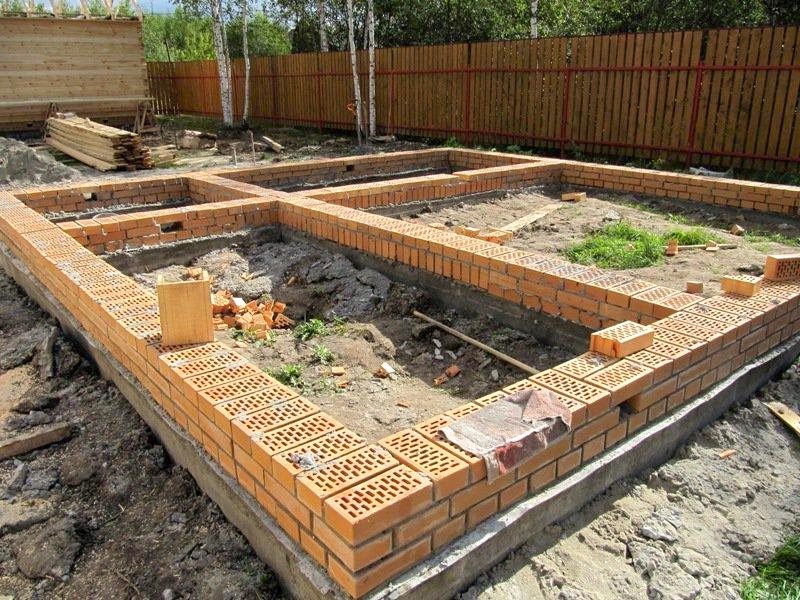 The construction of a foundation for a greenhouse from a bar begins with digging a shallow trench according to the size of the future greenhouse.
The construction of a foundation for a greenhouse from a bar begins with digging a shallow trench according to the size of the future greenhouse.
The brick foundation for a polycarbonate greenhouse can be made on a concrete strip base or independent from brick alone. In any case, you will need to dig a trench around the perimeter of the greenhouse. The bottom of the trench is cleaned and leveled. We considered the device of a strip foundation made of concrete in a separate article. & nbsp; For a purely brick foundation, the trench will have a smaller depth - cm 20.
We have to start with the question of possible limitations. They do not concern the possibilities for decoration and most often apply to projects of houses of standard series and old buildings.
If the foundation for the greenhouse is made of one brick, you should know that silicate brick is not suitable here, as it will quickly collapse under the influence of moisture coming from the soil. And even the foundation of baked bricks needs reliable waterproofing. First, a sand or gravel cushion 5-10 cm high is arranged at the bottom of the trench, after which a cement-sand mortar screed 10-15 cm thick must be made.
A prerequisite is that the screed must be level.
To do this, you can pull the cord or use the building level at least three meters long. A shorter level can be set on a flat bar or bar and in this way check the level of the screed. Otherwise, the brickwork may come out out of alignment, and then you will have to take additional measures to level the base before making the installation & nbsp; greenhouses on the foundation.
After the screed dries, a layer of roofing material is spread on it and brickwork begins.
For masonry mortars can be used:
Lime mortars with the addition of sand are considered the warmest, but they are not durable. Lime is extinguished in advance and ready-made should resemble the consistency of thick sour cream. Lime mortar can be prepared in proportions from 1:2 to 1:5, depending on the quality of the lime (its fat content). Currently, such mortars for masonry are used extremely rarely. But since the greenhouse is not a heavy structure, this option is also possible.
Cement-sand solutions are cold, but the most durable. Such solutions are prepared from a mixture of cement and sand in proportions from 1:3 to 1:6. The amount of cement in the mixture is determined by the brand of cement. It must be said that cement mortars have low plasticity, which introduces some inconvenience in working with them.
For laying a brick foundation for a greenhouse, however, as for other structures, it is preferable to use a lime-cement mortar. It is strong enough, plastic, which facilitates the work of erecting brick structures. It is prepared in various & nbsp; proportions, depending on the brand of cement, fat content of lime.
At present, there is no longer any need to prepare solutions on your own, calculating the amount of cement and sand, there is a fairly large selection of ready-made mixtures in stores, which you only need to fill with water, according to the instructions and stir.
Important! During operation, it is necessary to periodically mix the solution, preventing its separation.
They begin laying bricks for the foundation under the polycarbonate greenhouse from spreading the mortar. For the first row in our case, the solution will spread over the roofing material. The thickness of the bed (the so-called mortar layers between the rows) should be about 1 cm or a little more, the length at the rate of three to four bricks. It is recommended to start laying from two corners, laying out several bricks in height with bandaging of the seams. After that, a cord is stretched between them along the height of each row and the laying of the entire row continues. Bricklaying must be carried out with dressing of the seams so that the whole structure does not fall apart into separate fragments.
Important! When building a foundation for a greenhouse with your own hands, do not forget & nbsp; apply mortar to the end of the brick and press it against the previous brick so that the seam is completely filled with mortar. This will serve for better thermal insulation of brickwork.
The seams between the bricks, both horizontally and vertically, should be approximately the same and not exceed 1-1.2 cm. If desired, they can be embroidered until the mortar has hardened. This is done with a special tool "jointing" or any piece of wire of a suitable diameter.
Tip. In order not to break the bricks into halves and quarters, you must initially, if possible, calculate the length and width of the greenhouse corresponding to the size of the brick, taking into account the thickness of the joints.
Brick can be single, one and a half, double. Dimensions respectively:
However, modern manufacturers can produce bricks according to their own specifications, so the dimensions may differ from the standard ones.
For the subsequent fastening of the greenhouse to the foundation, it is necessary to lay embedded parts in the brickwork in the places where the vertical elements of the frame are installed. These can be vertical pins, bolts, metal plates, corners.
That's all that can be said briefly about the brick foundations under DIY greenhouses.
Comments on this post are no longer accepted.